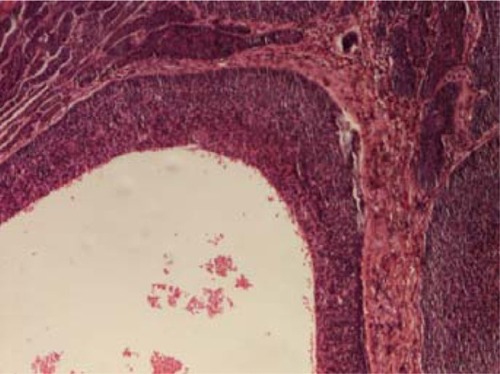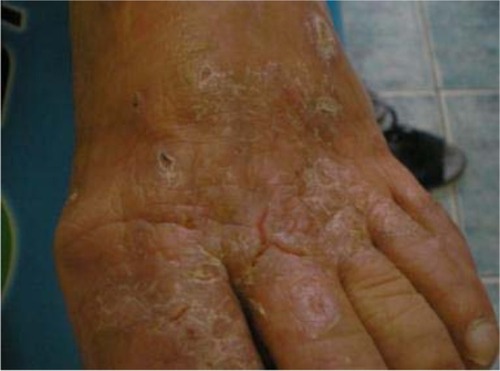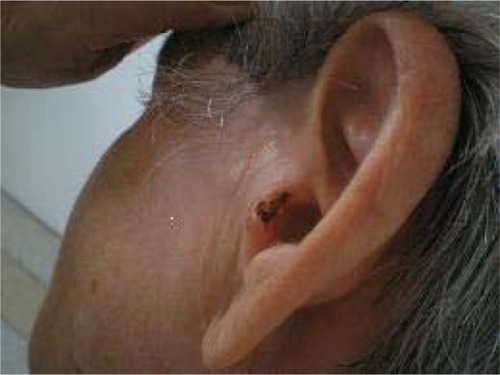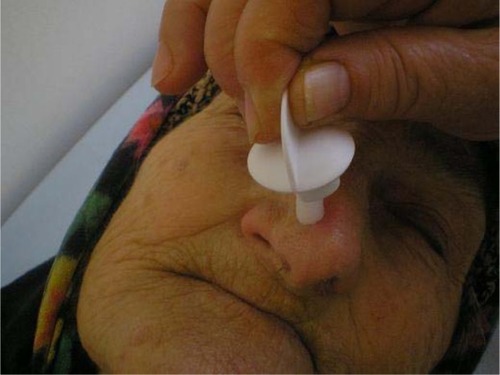Abstract
Basal cell carcinoma is a malignant skin tumor with high incidence in our country, especially in rural areas, on sun-exposed skin (particularly on the face) in elderly patients. We present three cases of basal cell carcinoma with good results with cryotherapy. This report aims to outline and to prove that in some difficult situations, a simple, inexpensive, easy-to-perform procedure with no contraindications and with minimal side effects (erythema, mild pain) can be applied and resolve such cases.
Keywords:
Case reports
Case 1
An 84-year-old woman was transferred from the cardiovascular department, where she was hospitalized for heart failure and atrial fibrillation, for a lesion on the dorsal aspect of the left foot that had developed a few months before hospitalization. She had no history of malignancies, nor previous trauma or sun or other type of radiation exposure. On dermatological examination, a round ulceration 21 mm in diameter surrounded by an inflammatory rim () was observed. No pain, no pruritus, no palpable lymph nodes were associated.
Figure 1 Ulceration on the dorsal aspect of the left foot: inflammatory rim around the ulceration, desquamation, and diffuse erythema.
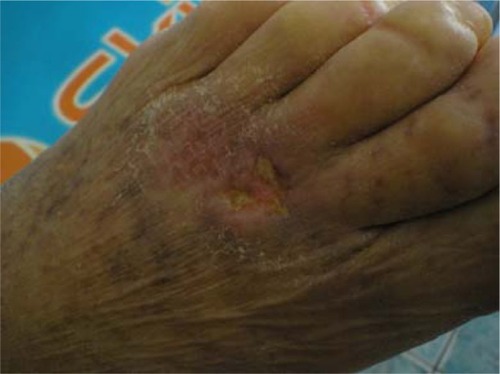
A biopsy specimen from the central part of the ulceration was taken, and the histopathological examination showed several basaloid island nests in the dermis, small hyperchromatic nuclei, and a palisading aspect, which led to a diagnosis of basal cell carcinoma – superficial type ().
Taking into consideration the heart failure, the atrial fibrillation, and anticoagulant therapy, topical cryotherapy (liquid nitrogen applied with a cotton swab) daily for 5 days was the optimal therapeutic choice accepted by the patient, her family, and the cardiologist.
Considering that according to most clinical practice guidelines for the management of basal cell carcinomas, the treated area should exceed 5 mm, after careful delineation of the excision area with a pen; liquid nitrogen was applied with a cotton swab of a size that covered the tumor plus 5 mm around it. In many cases, we applied more than the theoretically delineated line, taking care of the surrounding normal skin by covering it with sterile drape.
With only one ibuprofen tablet administration before the procedure and no anesthesia, the daily wound cryotherapy application was started. The patient did not complain of any side effects (except some slight pain), and finally, after a short hospitalization of a few hours, she was discharged from the hospital with minimal erythema and was monitored for more than a year and a half.
During the follow-up period, no other biopsy postcryotherapy was available, due to the age of the patient, associated diseases, and family disapproval. In regular clinical examinations, no cutaneous lesions that could possibly raise the suspicion of recurrence were observed, mild erythema and xerosis being comfortable and handled toward good evolution by emollients ().
Case 2
A 78-year-old woman was transferred from the cardiovascular department, where she was hospitalized for heart failure and hypertension, for a slow progressive lesion on the left tragus, observed by the patient a few years before the hospitalization. The medical history report included no malignancies, trauma or exposure to sun or other type of radiations.
Dermatological examination revealed an ulcerated tumor surrounded by inflammation (); the area was painful when touched and was not associated with any pruritus or palpable lymph nodes.
A punch biopsy was taken, and histopathology led to a diagnosis of basal cell carcinoma (). Cryotherapy was also applied once daily for 7 days, with ibuprofen orally when needed, without hospitalization or bandage application ().
Case 3
A 78-year-old female patient was referred to us from the otorhinolaryngology department for a basal cell carcinoma of the nose (), confirmed by histopathological report of a previous biopsy (). She was under treatment for dementia, and the family refused any surgical intervention. The patient was confused, under medication, and no medical data were provided by the family.
Figure 7 A small bleeding tumor covered by crust on the nose, multiple actinic keratosis on the face.
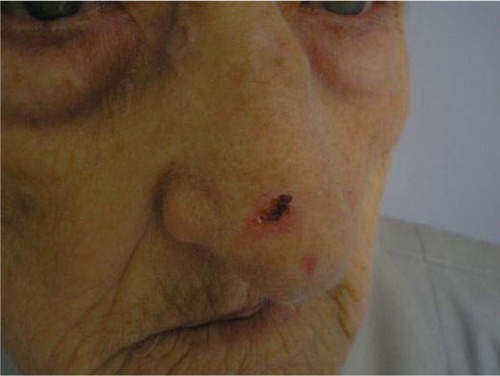
Figure 8 Basal cell carcinoma: typical nuclear palisading at the peripheral layer of the tumor (hematoxylin and eosin, 100×).
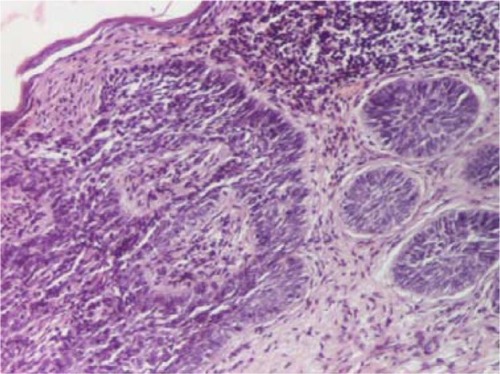
We applied 2 weeks’ (one application per 2-day interval) liquid nitrogen with a cotton swab (), through the same protocol described above, no anesthesia or other medication being necessary during the period of applications. There was no bleeding during the procedure, and very good compliance and cooperation from the patient.
Based on clinical grounds, we consider the final outcome excellent, with no claimed symptoms or local tumor recurrence at 1-year follow-up.
Discussion
Healthy tissue and malignant tissue cannot survive in extremely cold conditions, and will die due to ice formation in the fluid outside cells which results in cellular dehydration and intracellularly ice formation at −40°C or even less. The resulting intracellular ice crystals destroy the cells, bursting from both swelling caused by ice expansion inside the cell or shrinking caused by water exit from the cell, the ice forming within small tumor vessels, causing clotting. Since the average blood-clotting time is approximately 10 minutes and the extreme cold is maintained for at least 10–15 minutes, the lethal ice temperatures have been reached.
For lesions located on the nose, eyelids, and external ear, excision is complicated. Topical photodynamic therapy (PDT) has been previously applied with some results, but required pretreatment and displayed risk for recurrences,Citation1 associated or not with imiquimod.Citation2,Citation3 In these cases, cryotherapy is a good alternative to surgery.Citation1
PDT is generally well tolerated, but besides its price, has many side effects, ie, erythema, edema, erosions, and most patients complaining of severe pain that can last for days after the procedure.Citation4 This is not the case for cryotherapy, where slight erythema and mild pain can be related by some of the patients, important facts, especially when considering the selected age-group.
PDT is a form of phototherapy, a very different type of action than cryotherapy,Citation5,Citation6 that requires expensive modern equipment, skillful medical staff. The costs of the procedures are enhanced, and it is also a blind method of tumoral tissue destruction.
Cryotherapy is much easier to use, even in a trained general practitioner office, the method requiring minimal investments, with high effectiveness (although with no histological control), and it is easily accepted by most patients in some critical conditions.Citation7 Our cases were superficial basal cell carcinomas (as one can see in the clinical pictures and histopathological images).
The report of PeikertCitation1 emphasizes the good response of cryosurgery even in deeper or nodular basal carcinoma. In his report, 69 patients with 100 nonfacial tumors, ≤2 cm in diameter, consisting of superficial basal cell carcinoma, superficial nodular basal cell carcinoma with papillary dermal invasion, squamous cell carcinoma in situ, and squamous cell carcinoma with papillary dermal invasion, were treated with curettage and cryotherapy. And the results were more than promising: no recurrences after 1 year of follow-up. His conclusion was (like ours): “Curettage and cryosurgery is a simple, highly effective, and reliable treatment method for select, low-risk non-melanoma skin cancers.”Citation1,Citation6
Conclusion
Cryotherapy is an alternative treatment option when surgical removal of a tumor may be difficult or, for some patients, impossible; it is a localized therapy with minimal invasion, less costly, less pain during and after the procedure, and can be done in an outpatient clinic or during a short hospitalization.
Although further research is needed to determine its long-term effectiveness, cryotherapy has been shown to be effective in selected patients.
Disclosure
The authors report no conflicts of interest in this work.
References
- PeikertJMProspective trial of curettage and cryosurgery in the management of non-facial, superficial, and minimally invasive basal and squamous cell carcinomaInt J Dermatol20115091135113822126880
- MesseguerFSerra-GuillenCEcheverriaBA pilot study of clinical efficacy of imiquimod and cryotherapy for the treatment of basal cell carcinoma with incomplete response to imiquimodJ Eur Acad Dermatol Venereol201126787988121752102
- MoutranRMaatoukIStephanFTombRTreatment of nodular basal cell carcinoma with cryotherapy and reduced protocol of imiquimodCutis201290525625723270198
- EricsonMBWennbergAMLarköOReview of photodynamic therapy in actinic keratosis and basal cell carcinomaTher Clin Risk Manag2008411918728698
- MiXChaiWZhengHZuoYGLiJA randomized clinical comparative study of cryotherapy plus photodynamic therapy vs cryotherapy in the treatment of multiple condylomata acuminataPhotodermatol Photoimmunol Photomed201127417618021729164
- LezcanoLDi MartinoOBRodriguezMMKnopfelmacherOBolla de LezcanoLBowen’s disease treated with cryotherapy combined with topical 5% imiquimod. Alternative treatment to surgery in elderly patients with co-morbiditiesN Dermatol Online2011226164
- TalebiMFarmanbarNAbolfazliSSarraf ShiraziAManagement of physiological hyperpigmentation of oral mucosa by cryosurgical treatment: a case reportJ Dent Res Dent Clin Dent Prospects20126414815123277862
